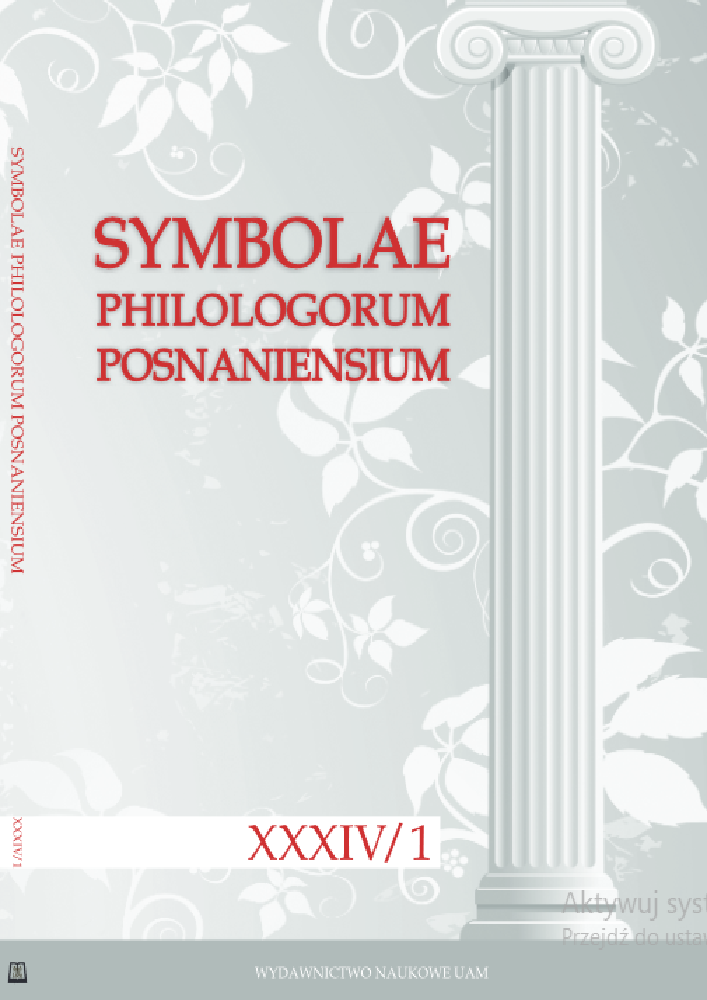Abstract
This paper aims to revise previous findings concerning lines 406–430 of Seneca’s Phaedra. Referring to the manuscript tradition, it demonstrates that the heading before 406 and the marginal notation used to identify speaking characters may have been misinterpreted as a result of this notation having been erased from codex Etruscus, the main representative of one of the two branches of the manuscript tradition of Seneca’s plays. Next, it argues that because of the formal consistency of this codex reading (E) – as contrasted with the inconsistencies in A – and the fact that E makes satisfactory sense here, the reconstructed reading of Etruscus should be taken into consideration in future editions of Seneca’s drama.
Literaturhinweise
Armstrong 2006: Armstrong, Rebecca. Cretan Women. Pasiphae, Ariadne, and Phaedra in Latin Poetry. Oxford: Oxford University Press, 2006. DOI: https://doi.org/10.1093/acprof:oso/9780199284030.001.0001
Boyle 1987: Boyle, Anthony James. Seneca’s Phaedra. Introduction, Text, Translation and Notes. Liverpool: Francis Cairns, 1987.
Chaumartin 1996: Chaumartin, François-Régis. Sénèque: Tragedies. Vol. 1. Introduction, édition et traduction. Paris: Les Belles Lettres, 1996.
Coffey, Mayer 1990: Coffey, Michael, Mayer Roland. Seneca: Phaedra. Introduction, Text, Commentary. Cambridge: Cambridge University Press, 1990.
Davis 1983: Davis, Peter J. “Vindicat Omnes Natura sibi: A Reading of Seneca’s Phaedra,” In Seneca Tragicus. Ramus Essays on Senecan Drama, edited by Anthony James Boyle, Victoria: Aureal Publications, 1983: 114–127. DOI: https://doi.org/10.1017/S0048671X00003660
de Meo 1990: de Meo, Cesidio. L. Anneo Seneca: Phaedra. Testo e commento. Bologna: Pàtron, 1990.
Fantham 1991: Fantham, Elaine. “Seneca’s Phaedra,” The Classical Review 41 no. 2 (1991): 330–332. DOI: https://doi.org/10.1017/S0009840X00280323
Fitch 2002: Fitch, John G. Seneca: Tragedies. Vol. 1. Text and Commentary. Cambridge, MA–London: Harvard University Press, 2002.
Fitch 2004: Fitch, John G. Annaeana Tragica. Notes on the Text of Seneca’s Tragedies. Leiden–Boston: Brill, 2004. DOI: https://doi.org/10.1163/9789047406006
Friedrich 1933: Friedrich, Wolf-Hartmut. Untersuchungen zu Senecas dramatischer Technik. Borna–Leipzig: Universitätsverlag von Robert Noske, 1933.
Gamberale 2007: Gamberale, Leopoldo. “Noterelle su Fedra in Seneca (e in Ovidio). A proposito della preghiera a Diana, Phaedr. 406 ss,” In Fedra. Versioni e riscritture di un mito classico. Atti del convegno AICC, Firenze, 2–3 aprile 2003, a cura di Rita Degl’Innocenti Pierini, Noemi Lambardi, Enrico Magnelli, Silvia Mattiacci, Saverio Orlando, M. Pace Pieri. Firenze: Polistampa, 2007: 57–84.
Giardina 2007: Giardina, Giancarlo. L. Anneo Seneca: Tragedie, Vol. 1. Edizione critica. Pisa–Roma, Fabrizio Serra, 2007.
Heldmann 1974: Heldmann, Konrad. Untersuchungen zu den Tragödien Senecas. Wiesbaden: Franz Steiner Verlag GMBH, 1974.
Kragelund 1999: Kragelund, Patrick. “Senecan Tragedy: Back on the Stage?” Classica et Mediaevalia 50 (1999): 235–247.
MacGregor 1971: MacGregor, Alexander P. “The MS Tradition of Seneca’s Tragedies: Ante renatas in Italia litteras,” Transactions and Proceedings of the American Philological Association 102 (1971): 327–356. DOI: https://doi.org/10.2307/2935947
MacGregor 1985: MacGregor, Alexander P. “The Manuscripts of Seneca’s Tragedies. A Handlist,” In Aufstieg und Niedergang der römischen Welt II 32.2, herausgegeben von Hildegard Temporini, Wolfgang Haase. Berlin–New York: Walter de Gruyter, 1985: 1135-1241.
Mayer 2002: Mayer, Roland. Seneca: Phaedra. London: Duckworth, 2002.
Philp 1968: Philp, Robert H. “The Manuscript Tradition of Seneca’s Tragedies,” The Classical Quarterly 18 no. 1 (1968): 150–179. DOI: https://doi.org/10.1017/S0009838800029190
Primmer 1976: Primmer, Adolf. “Die Vergleiche in Senecas Dramen,” Grazer Beiträge 5 (1976): 211–232.
Tarrant 1976: Tarrant, Richard J. Seneca: Agamemnon. Introduction, Text, Commentary. Cambridge: Cambridge University Press, 1976.
Viansino 1968: Viansio, Ioannes. L. Annaei Senecae Hercules Furens. Troades. Phoenissae. Medea. Phaedra. Torino: Paravia, 1968.
Vretska 1968: Vretska, Helmuth. “Zwei Interpretationsprobleme in Senecas Phaedra,” Wiener Studien NF 2 (1968): 153–170.
Zwierlein 1984: Zwierlein, Otto. Prolegomena zu einer kritischen Ausgabe der Tragödien Senecas. Mainz–Wiesbaden: Akademie der Wissenschaften und der Literatur, Franz Steiner Verlag GMBH, 1984.
Zwierlein 1986a: Zwierlein, Otto. L. Annaei Senecae Tragoediae. Incertorum auctorum Hercules [Oetaeus]. Octavia. Editio critica. Oxonii: e Typographeo Clarendoniano, 1986.
Zwierlein 1986b: Zwierlein, Otto. Kritischer Kommentar zu den Tragödien Senecas. Mainz–Stuttgart: Akademie der Wissenschaften und der Literatur, Franz Steiner Verlag GMBH, 1986.
Zwierlein 2004: Zwierlein, Otto. “Senecas ‘Phaedra’ und ihre Vorbilder nach dem Fund der neuen ‘Hippolytos’-Papyri,” In Otto Zwierlein: Lucubrationes Philologae, Band 1: Seneca, herausgegeben von Rainer Jakobi, Rebekka Junge, Christine Schmitz. Berlin–New York: Walter de Gruyter, 2004: 57–136. DOI: https://doi.org/10.1515/9783110904895-003
Lizenz
Copyright (c) 2024 Iwona Słomak

Dieses Werk steht unter der Lizenz Creative Commons Namensnennung 4.0 International.

